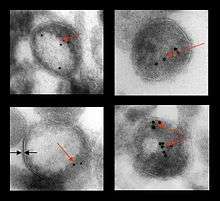Mitosome

A mitosome is an organelle found in some unicellular eukaryotic organisms. The mitosome has only recently been found and named,[1] and its function has not yet been well characterized. It was termed a 'crypton' by one group, but that name is no longer in use.
The mitosome has been detected only in anaerobic or microaerophilic organisms that do not have mitochondria. These organisms do not have the capability of gaining energy from oxidative phosphorylation, which is normally performed by mitochondria. The mitosome was first described in Entamoeba histolytica, an intestinal parasite of humans.[1][2] Mitosomes have also been identified in several species of Microsporidia[3][4] and in Giardia intestinalis.[5]
Mitosomes are almost certainly derived from mitochondria. Like mitochondria, they have a double membrane and most proteins are delivered to them by a targeting sequence of amino acids.[1][3][4] The targeting sequence is similar to that used for mitochondria and true mitochondrial presequences will deliver proteins to mitosomes.[1] A number of proteins associated with mitosomes have been shown to be closely related to those of mitochondria[2] or hydrogenosomes (which are also degenerate mitochondria).[6]
Current knowledge indicates mitosomes probably play a role in Fe-S cluster assembly, since they do not display any of the proteins involved in other major mitochondrial functions (aerobic respiration, haem biosynthesis) and they do display proteins required for Fe-S cluster biosynthesis (like frataxin, cysteine desulfurase, Isu1 and a mitochondrial Hsp70).[4]
Unlike mitochondria, mitosomes do not have genes within them. The genes for mitosomal components are contained in the nuclear genome.[1] An early report suggested the presence of DNA in this organelle,[7] but more recent research has shown this not to be the case.[8]
References
- 1 2 3 4 5 Tovar J, Fischer A, Clark CG (1999). "The mitosome, a novel organelle related to mitochondria in the amitochondrial parasite Entamoeba histolytica". Molecular Microbiology. 32 (5): 1013–21. doi:10.1046/j.1365-2958.1999.01414.x. PMID 10361303.
- 1 2 Bakatselou C, Beste D, Kadri AO, Somanath S, Clark CG (2003). "Analysis of genes of mitochondrial origin in the genus Entamoeba". The Journal of eukaryotic microbiology. 50 (3): 210–4. doi:10.1111/j.1550-7408.2003.tb00119.x. PMID 12836878.
- 1 2 Williams BA, Hirt RP, Lucocq JM, Embley TM (2002). "A mitochondrial remnant in the microsporidian Trachipleistophora hominis". Nature. 418 (6900): 865–9. Bibcode:2002Natur.418..865W. doi:10.1038/nature00949. PMID 12192407.
- 1 2 3 Goldberg AV, Molik S, Tsaousis AD, Neumann K, Kuhnke G, Delbac F, Vivares CP, Hirt RP, Lill R, Embley TM (2008). "Localization and functionality of microsporidian iron–sulphur cluster assembly proteins". Nature. 452 (7187): 624–8. Bibcode:2008Natur.452..624G. doi:10.1038/nature06606 (inactive 2015-01-12). PMID 18311129.
- ↑ Tovar J, León-Avila G, Sánchez LB, Sutak R, Tachezy J, van der Giezen M, Hernández M, Müller M, Lucocq JM (2003). "Mitochondrial remnant organelles of Giardia function in iron-sulphur protein maturation". Nature. 426 (6963): 172–6. Bibcode:2003Natur.426..172T. doi:10.1038/nature01945. PMID 14614504.
- ↑ Dolezal P, Smíd O, Rada P, Zubácová Z, Bursać D, Suták R, Nebesárová J, Lithgow T, Tachezy J (2005). "Giardia mitosomes and trichomonad hydrogenosomes share a common mode of protein targeting". Proceedings of the National Academy of Sciences of the United States of America. 102 (31): 10924–9. Bibcode:2005PNAS..10210924D. doi:10.1073/pnas.0500349102 (inactive 2015-01-12). PMC 1182405
 . PMID 16040811.
. PMID 16040811. - ↑ Ghosh S, Field J, Rogers R, Hickman M, Samuelson J (2000). "The Entamoeba histolytica Mitochondrion-Derived Organelle (Crypton) Contains Double-Stranded DNA and Appears to Be Bound by a Double Membrane". Infection and Immunity. 68 (7): 4319–22. doi:10.1128/IAI.68.7.4319-4322.2000. PMC 101756
 . PMID 10858251.
. PMID 10858251. - ↑ León-Avila G, Tovar J (2004). "Mitosomes of Entamoeba histolytica are abundant mitochondrion-related remnant organelles that lack a detectable organellar genome". Microbiology. 150 (Pt 5): 1245–50. doi:10.1099/mic.0.26923-0. PMID 15133087.